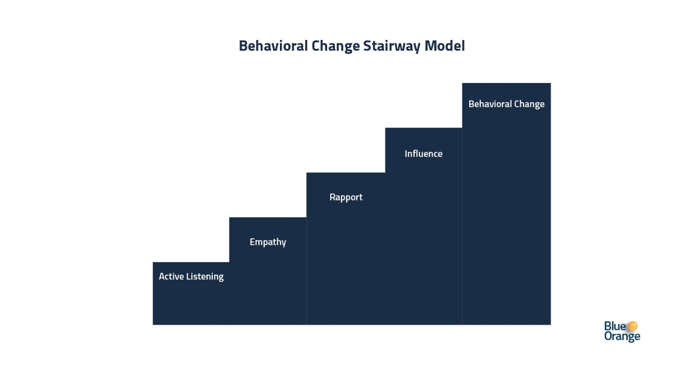There are 6 hostages in a building. The hostage-taker says he’ll start shooting in an hour if his demands are not met. You’re handed the phone to negotiate. What do you do?
While this situation seems a world away from your typical day at a credit union, the principles for navigating them are the same. Personal influence and a process for building it are the keys to successfully negotiating uncertainty and leading change in all domains.
Working for a data science agency, the question CU leaders often ask us is, “How can I create data transformation at my credit union?” Implementation and integration are where the rubber meets the road with predictive analytics. A technical solution without this is not a solution at all. If you have full executive buy-in, project funding and a mandate, the path to data-driven decision making is clear. But what if you don’t?
One of our favorite frameworks for supporting change in a resistant organization is the Behavioral Change Stairway Model (BCSM). It is a negotiation model used by the FBI in high stakes hostage situations that is broadly applicable for developing a relationship and influence. The negotiator/influencer must successfully complete each step before moving on to the next. For instance, you need to establish empathy (stage 2) before moving onto rapport (stage 3).

Stages:
- Active Listening
- Empathy
- Rapport
- Influence
- Behavioral Change
- Active Listening
Everyone has a desire to be heard and understood. Active listening is a foundational skill for building the relationship and eventually implementing behavioral change. It involves core activities: Mirroring, paraphrasing, summarizing; and supplemental ones once the core skills are working: effective pauses, emotional labeling, I statements. Because few of us are trained listeners, it’s informative to see this stage broken down into technical skills that one can bring into any conversation.
- Empathy
The goal is to establish a relationship through effective communication. Empathy allows you to see through the eyes of the other person and absorb some of the emotional tension. This connection is critical for building rapport. Focus on your tone of voice, which conveys concern for and interest in the other party.
- Rapport
In this stage, the relationship stops being one-sided and you begin building the themes of change. By the end of stage 3, the other party should be amenable to your behavioral change efforts. Focus on minimizing negative behaviors and blend with the subject by agreeing where possible without conceding, reducing real or perceived differences, and finding common ground.
- Influence
At this stage, a relationship has been established and the subject is willing to accept your suggestions for behavior change. You have “earned the right” to recommend a course of action due to your collaborative problem-solving approach. Now you can work together to identify realistic solutions and alternatives.
- Behavioral change
If the previous stages have been effectively completed, the other party will likely follow your suggestions. However, there are two common pitfalls: moving too rapidly through the stages, and omitting stages in a misguided effort to prematurely problem solve. The BCSM approach is a proven model for hostage negotiators to quickly establish relationships and successfully resolve life and death crises through interpersonal influence. Don’t skip steps.
So how does this work at work? Generating buy-in for behavioral change is hard. Building up the resources and mindsets to rely on data for decision making is often a complicated organizational dance. But if this is your objective, the BCSM is a proven way to approach and influence other leaders at your credit union. Hopefully, you find the framework helpful and get the results (and better relationships) from climbing the stairway together.
Blue Orange is a data transformation and predictive analytics agency focused on simplifying data for credit unions. If you’d like to learn more, schedule a free data strategy call for your CU.







